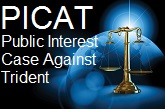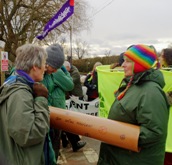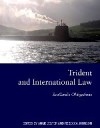This briefing originally appeared on the website of the Oxford Research Group and can be accessed from their website.
Paul Rogers
14 December 2012
Will the period 1945-2045 be the most significant in human history? Our regular monthly briefings by our Global Security Consultant, Paul Rogers, address current trends in global insecurity. Whilst these briefings often touch upon alternatives to the mainstream security paradigm, he has taken the opportunity, with this last briefing of 2012, to reflect more broadly on the opportunities for peace in the second decade after the ‘war on terror’ - informed by a longer survey of peace and conflict since 1945. Over the past few years, Paul Rogers has done numerous talks for very different audiences about future causes of conflict and how these might be addressed. This briefing is a special and personal attempt to write up and share his various notes from these speeches and put them into one briefing.
Where to Start?
We survived the Cold War, the most dangerous period in human history so far. Well, most of us did.
In reality, more than ten million people died and tens of millions more were wounded in proxy wars involving the superpowers - in Korea, Vietnam, the Horn of Africa, Central America, Afghanistan and elsewhere. Some places took decades to recover, others never have.
It is true that at least an all-out nuclear war was avoided, but there were huge risks, many accidents and some exceptionally dangerous crises. Put bluntly, we were very lucky to come through it without a catastrophe.
Moreover, for forty-five years, massive amounts of money and immense human resources were diverted away from far more important tasks to fuel war machines which, at their peak, employed tens of millions of people, wasted billions of pounds, produced vast masses of armaments, including over 60,000 nuclear weapons and threatened world-wide destruction. The many millions of lives that were lost through poverty, disease and malnutrition across the world through this appalling waste are rarely acknowledged.
More than twenty years later, the nuclear dangers are still far from over, even if we are on something more like a slippery slope to a proliferated world, rather than staring over the edge of an appalling nuclear abyss, and there is still much to do to save us from our capacity for self-destruction.
Even so, in the early 1990s, after the end of the Cold War, there seemed the prospect of a more peaceful world order, but it disappeared in the face of deep and enduring conflicts, not least in the first Gulf War, and the bitter conflicts in the Balkans, the Caucasus and the African Great Lakes.
Bill Clinton’s first CIA Director, James Woolsey, characterised the changed world in the mid-1990s as one where the West had slain the dragon of the Soviet Union but was now facing a jungle full of poisonous snakes.(1) The jungle had to be tamed to maintain stability, and this was an attitude that came to the fore in an extraordinarily robust response to the 9/11 atrocities. It failed to control political violence and led to two major wars and persistent conflict across the Middle East and South Asia.
These are trends of the immediate past and present, but the issues that will come most to dominate international conflict relate only partially to them. What is much more necessary is to recognise the underlying trends that could be at the core of insecurity and conflict in the decades to come, and to understand how we can avoid their becoming the drivers of conflicts that may dwarf the problems of recent years including even the “war on terror”.
Divisions and Constraints
There are two root issues that will increasingly interrelate – socio-economic divisions and environmental constraints, especially climate change.
1.Rich-Poor World
In the past 60 years, the world economy has experienced almost continual growth. Until 1980, that was largely on the basis of a mixed economy model competing with the centrally planned economies of the Soviet bloc and China. From the early 1980s, the trend was toward a much more neoliberal free market approach with privatisation of state assets across many countries, the freeing up of markets and less regulation of trade and financial markets.
Ideas of a more planned world economy linking fair trade with development had been proposed in the 1960s, especially by the UN Conference on Trade and Development (UNCTAD). They reached their peak with the intended New International Economic Order of 1974, which would have promoted integrated commodity agreements, tariff preferences and other processes designed to improve the trading and development prospects of the Global South. These progressive proposals withered away by the end of the decade in the face of a determined neoliberal economic agenda.
This was pursued, in particular, by the Reagan administration in the United States and the Thatcher government in the UK, but was more generally embraced by other states and especially by international financial institutions, such as the World Bank and the International Monetary Fund, in what became known the “Washington Consensus”.
It was an outlook that got a boost with progressive deregulation of financial institutions in the late 1980s, especially the “Big Bang” for the London’s financial institutions in 1986. There was then a further boost because of the collapse of the centrally planned system of the Soviet bloc in 1990-91, even though Russia’s subsequent embrace of unbridled capitalism actually set back its own economy by a decade or more, wrecked the lives of millions of people, and still leaves a legacy of bitterness.
Across the world, economic growth continued, albeit at a slower rate than 1950-80, but what became increasingly clear was that it was becoming more and more unbalanced, with the benefits of growth falling mostly into the hands of around one fifth of the global population. While the poorest people did not generally get poorer, levels of malnutrition actually increased substantially, but what was even more significant was that by the early 21st Century, the great majority of all the world’s wealth and annual income – close to 85% - was shared by about 1.5 billion people out of a world population heading towards 7 billion.
This division had become steadily more pronounced in the last two decades of the 20th Century, but one major feature of the change was that it was no longer a matter of “rich country/poor country” – more a very large trans-global elite disproportionately sharing the benefits due to the entire world community.
This now includes hundreds of millions of people in China, India, Brazil and many other countries across the South, even if the “old rich” countries of the Atlantic alliance still dominate. On top of this, is a very much smaller trans-global “super-elite”, including many thousands of multi-millionaires. At the same time, along with the marginalised majority of billions of people across the South, there is also a marginalised minority, sometimes of tens of millions of people, in the old rich states of the West.
This failure to deliver socio-economic justice is particularly evident in the fast-growing Asian development region. According to the Asia Development Bank’s 2012 Asia Development Report, if there had been more even distribution of the fruits of growth “another 240 million people in the 45 countries that make up developing Asia would have moved out of poverty in the last two decades”.(2)
What is insidious is that we are faced with a deep-seated trend, which is persistently disguised by the more obvious signs of economic development. City tower blocks, beach hotels, safari parks and many other accoutrements of partial economic success all too frequently disguise deep and enduring divisions, with richer people living and travelling in cocoons of well-being, not seeing the slums that ring the cities or the endemic rural poverty.
Because of the size of the successful elite - more than one-fifth of the world’s population - it acts as a self-contained, if large, global entity that benefits from material well-being that is largely taken for granted. Moreover, it is for the most part a community that persistently fails to recognise the endemic mal-distribution of world wealth and income.
Thus the minority world lives alongside the majority world but is hardly conscious of the very existence of the divide. Rarely does it acknowledge the sustained benefit gained from appalling low wages and working conditions of hundreds of millions of people producing cheap goods, nor the existence of a trading system dominated by transnational corporations and favouring production of low-cost commodities at the expense of poor farmers and miners across the world.
A Success with Consequences
At the same time, none of this should diminish the progress that has been made in some aspects of international development, not least education. Forty years ago, one of the greatest challenges facing the countries of the South was the impoverishment of education, with only a minority of children getting even four years of primary education. That has changed dramatically, and most children now get a basic education. Even the pernicious gender gap is slowly narrowing.
This success has been achieved mostly by determined efforts of peoples and governments and it has more recently been combined with huge improvements in communications. There are still many communities that are notably “data poor”, but the combination of improved education, literacy and communications has been one of the great development success stories of the past four decades.
Yet, there is a very powerful consequence of this in that far more people are aware of their own marginalisation. It is a phenomenon that particularly affects young people across the majority world who are educated at least to high school level but have few job prospects or hopes for a reasonable standard of living. With the current recession, this is also being experienced in rich states such as Greece and Spain, with eruptions of discontent and protest onto the streets as well as the ”Occupy” and other new social movements. It has certainly added greatly to the much more widespread frustration and anger with Middle East autocracies that has underpinned the Arab Awakening that started early in 2011.
In the 1970s, it was common in countries such as Britain to talk of a “revolution of rising expectations” as the consumer society and economic growth always promised more. People would be reasonably content, because, whatever the particular problems of national economies, the overall picture was of a promise of economic growth and innovation delivering better material well-being. What is more likely in the early 21st Century is a “revolution of frustrated expectations” as people among the marginalised majorities become more aware of their own marginalisation, leading to despair, resentment and anger.
2. Environmental Limits
On its own, the problem of a socio-economically divided world is ethically unacceptable, as well as being potentially unstable. The more the divisions endure in an increasingly connected world, the more there is the risk of anger and revolts from the margins, but what is even more important is that these persistent divisions are working in parallel with global environmental constraints – the inability of the global ecosystem to absorb human impacts, especially the carbon emissions that are leading to climate change.
Environmental constraints are many, and they include major issues of water resource use, as well as competition and conflict over strategic minerals, especially in Central Africa. The buying up of land by foreign interests, not least in Africa and Latin America, is a further example. In terms of the world’s non-renewable resources, the concentrated location of oil and gas is the most remarkable. More than 60% of the world’s readily accessible high quality oil is found in just five countries around the Persian Gulf – Iran, Iraq, Kuwait, Saudi Arabia and the UAE – with another 20% in Russia, Kazakhstan and Venezuela. The concentration of natural gas is even more extreme, with over half the world reserves in just three countries – Russia, Iran and Qatar.
Such a narrow resource base for these energy reserves is at the root of the strategic importance of the Persian Gulf and does much to explain recent and current conflicts, but the even greater global concern stems more from the potential impact of climate change.
Put in its most basic form, huge fossil fuel reserves of coal, oil and gas were laid down over millions of years, mainly during the Carboniferous Era, and large quantities of the carbon locked up in these reserves are now being released into the atmosphere, not in millions or even thousands of years but in centuries and, to some extent, even just decades. Most of this carbon release is in the form of carbon dioxide and this gas increases the absorption of the sun’s radiation in the atmosphere. The overall impact is one of increasing temperatures and that is already happening, but this is not a uniform process across the world.
Until about twenty years ago, climate research suggested that the most pronounced impacts of climate change would be felt in the temperate latitudes. For the most part, these were the wealthier regions of the world and might best be able to cope. That view has changed dramatically, and it is now clear that the impact of climate change will indeed be asymmetric, but not in the way originally thought.
weather events – so-called “global weirding” - may turn out to be advanced warnings of climate change, like the canary in the coal mine, and if there has been enough “suggesting the possible”, then the change can happen before excessive suffering.
Much good work is already being done and there are innumerable examples from right across the world. Take just three examples from the hundreds in Britain alone: the Centre for Alternative Technology’s extensive work on renewables and energy conservation, the New Economics Foundation’s Great Transition project, and Oxford Research Group’s work on sustainable security. Don’t forget, also, that there are close to a billion members of cooperatives in over a hundred countries.
We also need a broader sense of perspective. There is sound evidence that the 1990s saw more conflicts and loss of life world-wide than the first decade of the 21st Century, in spite of the impact of the war on terror. More generally, if we look back over several centuries, there is a legitimate argument that, given the growth in the world’s population, proportionally fewer people have been the victims of violence, including war, over the past fifty years than in similar periods in previous centuries. (6) This does not mean that there is even a remote case for complacency, especially given the increase in destructive power of weapons, and the threat to the whole global environment, but it does help give a sense of hope.
A Century on the Edge – and of Hope
As individuals we may feel thoroughly daunted in the face of the changes that need to be made, yet each of us may have skills, knowledge and abilities that lie in particular directions and can vary greatly. However modest we think our individual contributions may be, they still help and they really can add to the efforts of many others into something really powerful.
In this we need to remember three things. Any one person is part of a whole movement, and recognising the big picture while contributing to one part of it makes great good sense. The second is that knowledge really is power – it is ever so important that we learn from all the many sources of information and ideas that are now in circulation, a process made much easier by the new social media. This enables us to be much more effective in expressing what needs to be done, and to convince others. Finally, there is the essential need to maintain a sense of hope, even during times of pessimism. Indeed, on the matter of hope, there is a particular way of looking at things which can actually help.
We may, in our arrogance, always think that our own time of living is the most significant in human history, but there is a sense in which one particular century, from 1945 to 2045, may actually fulfil that definition.
Why 1945?
Well, that’s easy. The first atom bomb was tested in July; two Japanese cities were destroyed the following month, and within a decade, the world was in the midst of an appallingly dangerous nuclear arms race that could have set our world community back centuries. We had, for the first time in millions of years of human evolution, developed the means to wreak utter destruction world-wide.
As was remarked back in the introduction, we avoided it largely by luck, and we are not out of the woods even now. Yet we may be learning slowly to cope with our capacity for self-destruction, even if we have many challenges to come, not least from the potential misuse of bio-molecular science and nanotechnologies.
Why, then, 2045?
That is not so straightforward but revolves around the idea that we now have the potential to cause huge damage to our environment, including diminishing prospects for our own well-being. That, too, can be overcome, and we need to be well on the way by 2045 - indeed the second decade of this century is the period in which serious change must start.
The Key Decade
If we succeed, then there is every chance that young children who are alive now will look back in their later life, perhaps even at the dawn of the 22nd century and recognise, happily, that there was enough wisdom, energy and commitment eighty or so years earlier to begin the changes that helped make the 21st century the most peaceful, just and sustainable period in human history. That is what makes this second decade of the 21st Century so important. If we can really begin the transformation by 2020, and if that leads on to much greater progress in the 2020s, then we can approach the following years not just with hope, but with confidence, too.
Notes
(1) Statement by James Woolsey at Senate hearings, February 1993.
(2) Neena Bhandari, “Rising Inequality Could be Asia’s Undoing”, TerraViva- Inter Press Services, UN, New York, 13 April 2012.
(3) Edwin Brookes, “The Implications of Ecological Limits to Development in Terms of Expectations and Aspirations in Developed and Less Developed Countries”, chapter in; Anthony Vann and Paul Rogers (editors), Human Ecology and World Development, Plenum Press, London and New York, 1974.
(4) Paul Rogers, Losing Control: Global Security in the 21st Century, (1st edition) Pluto Press, London, 2001.
(5) The Costs of War, a report from the Eisenhower Research Project of the Watson Institute for International Studies at Brown University, Providence RI, June 2011, available at www.costsofwar.org
(6) This is a point powerfully argued by Steven Pinker in his book, The Better Angels of Our Nature, (Viking Press, New York, 2011).
Further Information
There is a mass of information available on the issues covered here, so the following sources are just a beginning.The Oxford Research Group is a helpful source on sustainable security and related issues (www.oxfordresearchgroup.org.uk and www.sustainablesecurity.org)
One of the best web journals covering a huge range of topics is Open Democracy (www.opendemocracy.net). It is particularly good in terms of the wide range of people who write for it and the breadth of subjects covered
Information on the New Economics Foundation’s Great Transition project is available on the NEF website (www.neweconomics.org)
Of the groups campaigning on development issues, see especially the World Development Movement (www.wdm.org.uk/)
Carbon Brief provides copious information on climate change (www.carbonbrief.org/)
A good source on renewables and energy conservation is the Centre for Alternative Technology in Mid-Wales (www.cat.org.uk)
A useful resource on international peace and security issues is Open Briefing (www.openbriefing.org)
One recent book that focuses on land-grabbing in the Global South and, in the process, says much about how the entire current system runs, is Fred Pearce’s The Landgrabbers: The New Fight Over Who Owns the Earth, (Eden Project Books, 2012).
Background to this Briefing
Over the past few years, I have done numerous talks, mostly in the UK, about future causes of conflict and how these might be addressed. The groups have varied greatly, from Quaker meetings, UNA branches, world affairs discussion groups, and students in schools and colleges, through to business people, politicians and classes at defence colleges.
Mainly because of my own disorganisation my notes tend to be “back of the envelope” stuff, and the talks get updated and evolve in a rather unstructured way. There are, though, invariably lively discussions and disagreements, and I’ve been getting comments at the end of the sessions along the lines of “have you written this up anywhere?” I’ve had to say “no” until now, so this is an attempt to try and do just that.
Quite a few people have been kind enough to comment on drafts of this pamphlet, and I’ve also benefited hugely from the many discussions at the talks. Thanks very much to all those, who have passed on ideas. However, I’m responsible for the end result.
About the Author
Paul Rogers is Global Security Consultant to Oxford Research Group (ORG) and Professor of Peace Studies at the University of Bradford. He writes regular reports and monthly global security briefings for ORG. They are available from our website, where visitors can sign-up to receive them via email each month.
Source: Oxford Research Group












 Nuclear weapons crime in the UK has been reported to Thames Valley Police.
Nuclear weapons crime in the UK has been reported to Thames Valley Police.










